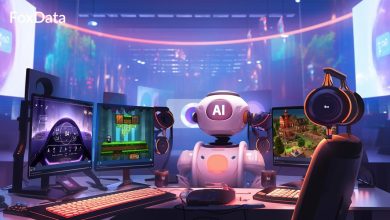Artificial Intelligence in Gaming
Artificial Intelligence in Gaming: Redefining the Player Experience

Introduction:
In the realm of gaming, artificial intelligence (AI) stands as a transformative force, reshaping the way games are designed, played, and experienced. From intelligent NPCs (non-player characters) to procedural content generation and adaptive difficulty systems, AI technologies are revolutionizing every aspect of the gaming landscape, offering players new levels of immersion, challenge, and personalization. Let’s delve into the captivating world of AI in gaming and explore how it is redefining the player experience.
Intelligent NPCs: Bringing Virtual Worlds to Life:
One of the most compelling applications of AI in gaming is the creation of intelligent NPCs that exhibit lifelike behaviors, emotions, and personalities. Gone are the days of scripted, predictable NPCs; today’s AI-driven characters possess the ability to adapt to player actions, learn from their experiences, and make decisions based on complex algorithms and behavioral models. Whether it’s a cunning enemy in a first-person shooter, a strategic ally in a role-playing game, or a dynamic crowd in a sports simulation, intelligent NPCs add depth, realism, and immersion to virtual worlds, making the gaming experience more engaging and memorable.
Intelligent NPCs: The Architects of Virtual Realism in AI Gaming
In the vast expanse of virtual worlds, non-player characters (NPCs) serve as the very fabric that weaves together the immersive tapestry of gaming experiences. Yet, it’s not just their presence that matters; it’s their intelligence that truly breathes life into the digital realms we explore. Enter the realm of Intelligent NPCs, where artificial intelligence (AI) technologies converge to create characters that think, act, and interact with players in ways that mimic the complexity of human behavior. In the crucible of AI gaming, Intelligent NPCs stand as the architects of virtual realism, transforming digital landscapes into dynamic, immersive worlds where every encounter is a journey of discovery and every interaction is an opportunity for engagement.
Evolution of NPC Intelligence:
The evolution of NPC intelligence in gaming is a testament to the remarkable advancements in AI technology over the years. Gone are the days of static, one-dimensional NPCs that merely serve as cannon fodder or quest dispensers. Today’s Intelligent NPCs are endowed with a level of autonomy, adaptability, and complexity that rivals that of their human counterparts. Through the integration of sophisticated AI algorithms, machine learning techniques, and behavioral modeling, game developers can imbue NPCs with the ability to perceive their environment, make decisions based on contextual cues, and even learn and evolve over time.
Dynamic Behaviors and Reactions:
What sets Intelligent NPCs apart is their ability to exhibit dynamic behaviors and reactions that mirror the complexity of human psychology. Whether it’s reacting to player actions, adapting to changing circumstances, or expressing emotions through facial expressions and body language, these NPCs bring a level of depth and realism to virtual interactions that was once unimaginable. From engaging in meaningful conversations and forming alliances to displaying fear, anger, or joy in response to stimuli, Intelligent NPCs add layers of complexity and nuance to the gaming experience, creating memorable moments of immersion and emotional resonance.
Adaptive AI and Player Engagement:
One of the key strengths of Intelligent NPCs lies in their adaptive AI capabilities, which allow them to dynamically adjust their behavior and difficulty level based on player actions and skill level. By analyzing player performance, behavior, and preferences in real-time, these NPCs can tailor their responses, tactics, and challenges to provide a personalized and engaging experience for each player. Whether it’s ramping up the difficulty during intense combat encounters, providing hints and guidance during puzzle-solving sequences, or adapting their dialogue and interactions to reflect the player’s choices and personality, Intelligent NPCs enhance player engagement by creating a sense of agency, immersion, and connection within the game world.
Narrative Depth and Immersion:
In addition to enhancing gameplay mechanics, Intelligent NPCs play a pivotal role in shaping the narrative depth and immersion of gaming experiences. Through their interactions, dialogues, and relationships with the player and other characters, these NPCs contribute to the richness and complexity of the game world, weaving together intricate storylines, subplots, and character arcs that draw players deeper into the narrative tapestry. Whether it’s forming alliances, forging rivalries, or embarking on epic quests together, the relationships and interactions players share with Intelligent NPCs become a central driving force behind the player’s journey, imbuing the gaming experience with a sense of depth, meaning, and emotional resonance.
Challenges and Future Directions:
Despite the remarkable progress made in the field of Intelligent NPCs, there are still challenges and opportunities for further advancement. As AI technologies continue to evolve, game developers face the ongoing challenge of balancing realism with gameplay balance, ensuring that Intelligent NPCs provide a challenging yet fair experience for players. Additionally, there is the opportunity to explore new frontiers in NPC intelligence, such as incorporating advanced natural language processing (NLP) techniques for more natural and immersive dialogue interactions, or integrating emotional modeling algorithms to create NPCs with even greater emotional depth and complexity.
Conclusion: The Promise of Intelligent NPCs:
In conclusion, Intelligent NPCs represent a paradigm shift in gaming, transforming virtual worlds into dynamic, immersive landscapes where every interaction is an opportunity for engagement, exploration, and discovery. Through the integration of advanced AI algorithms, machine learning techniques, and adaptive behavior modeling, these NPCs bring a level of realism, depth, and nuance to gaming experiences that transcends traditional boundaries. As AI technologies continue to evolve and mature, the promise of Intelligent NPCs holds boundless potential, offering players an ever-expanding universe of immersive, dynamic, and engaging experiences that blur the line between reality and fiction. In the tapestry of AI gaming, Intelligent NPCs stand as the architects of virtual realism, shaping the future of interactive entertainment and redefining the way we play, connect, and experience games.
Procedural Content Generation: Endless Worlds to Explore:
Another groundbreaking application of AI in gaming is procedural content generation, a technique that leverages algorithms to dynamically generate game content such as levels, environments, and quests. By harnessing the power of AI, developers can create vast, procedurally generated worlds that offer players endless opportunities for exploration, discovery, and adventure. Whether it’s an open-world sandbox game, a roguelike dungeon crawler, or a space exploration sim, procedural content generation allows developers to create rich, immersive gaming experiences that evolve and adapt to player actions in real-time.
Procedural Content Generation (PCG) in Artificial Intelligence Gaming: Crafting Endless Worlds of Exploration
In the realm of artificial intelligence (AI) gaming, procedural content generation (PCG) stands as a revolutionary concept, reshaping the landscape of game design and player experience. PCG offers a dynamic approach to content creation, utilizing algorithms and AI techniques to generate game content such as levels, environments, characters, quests, and more in real-time. This innovative approach not only offers developers the ability to create vast, diverse virtual worlds but also provides players with endless opportunities for exploration, discovery, and adventure. Let’s embark on a journey through the captivating realm of procedural content generation in AI gaming and explore how it is crafting endless worlds for players to explore.
Unleashing Creativity Through Algorithms:
PCG liberates game developers from the constraints of traditional content creation methods by harnessing the power of algorithms to generate content dynamically. Instead of manually designing every aspect of a game world, developers can use procedural algorithms to generate content on-the-fly based on predefined rules, parameters, and algorithms. This approach allows for the creation of vast, complex virtual worlds that are rich in detail and variety, offering players an unparalleled sense of immersion and freedom to explore.
Endless Exploration, Infinite Possibilities:
One of the most compelling aspects of PCG is its ability to create virtually limitless worlds for players to explore. Whether it’s a sprawling open-world landscape, a labyrinthine dungeon filled with secrets and treasures, or a procedurally generated galaxy teeming with alien civilizations, PCG ensures that players are always presented with new challenges and discoveries with each playthrough. This endless variety and unpredictability add depth and replayability to games, enticing players to return to these virtual worlds time and time again to uncover their secrets and unravel their mysteries.
Adaptive Gameplay and Dynamic Challenges:
PCG also enables developers to create gameplay experiences that adapt and evolve based on player actions and decisions. By dynamically generating content such as enemy encounters, loot drops, and environmental hazards, PCG ensures that each playthrough feels fresh and engaging, offering players a unique set of challenges and opportunities to overcome. Whether it’s adjusting the difficulty level based on player skill, tailoring quests and objectives to match player preferences, or introducing new gameplay mechanics and surprises, PCG keeps players on their toes and ensures that no two playthroughs are ever the same.
Empowering Developers, Inspiring Innovation:
For game developers, PCG represents a powerful tool for unleashing creativity and innovation. By automating the content creation process, PCG frees developers from the tedious and time-consuming task of manually designing every aspect of a game world. Instead, developers can focus their efforts on fine-tuning procedural algorithms, experimenting with new gameplay mechanics, and refining the overall player experience. This flexibility and freedom enable developers to push the boundaries of game design, creating experiences that are truly unique, immersive, and memorable.
Challenges and Opportunities Ahead:
Despite its many advantages, PCG also presents developers with a unique set of challenges and opportunities. Balancing procedural generation with handcrafted content, ensuring gameplay balance and pacing, and maintaining a sense of coherence and consistency across dynamically generated worlds are just a few of the challenges developers face when implementing PCG in their games. Additionally, there is the ongoing challenge of creating procedural algorithms that are flexible, robust, and capable of generating diverse, high-quality content that meets the expectations of players. However, with careful planning, experimentation, and iteration, developers can overcome these challenges and harness the full potential of PCG to create unforgettable gaming experiences.
Conclusion: The Promise of Procedural Content Generation:
In conclusion, procedural content generation represents a paradigm shift in game design, offering developers new tools and techniques for creating vast, immersive worlds that evolve and adapt to player actions in real-time. From endless exploration and dynamic challenges to adaptive gameplay and limitless creativity, PCG is redefining the boundaries of gaming, empowering developers to craft experiences that are as diverse and unpredictable as the players who inhabit them. As AI technologies continue to evolve and mature, the promise of procedural content generation holds boundless potential, offering developers new opportunities to innovate, experiment, and create gaming experiences that push the boundaries of what is possible in interactive entertainment.
Procedural Content Generation: The Boundless Frontier of AI Gaming:
In the vast and ever-expanding universe of gaming, one concept stands as a beacon of innovation and endless possibilities: procedural content generation (PCG). This revolutionary approach to game design leverages the power of artificial intelligence (AI) to dynamically generate game content such as levels, environments, quests, and characters, offering players a virtually limitless array of worlds to explore, challenges to overcome, and adventures to embark upon. From sprawling open-world epics to intimate roguelike adventures, procedural content generation is redefining the boundaries of gaming, transforming static experiences into dynamic, ever-evolving landscapes where every playthrough is a unique journey of discovery and exploration.
Procedural Content Generation (PCG): A Revolution in AI Gaming:
In the expansive realm of artificial intelligence (AI) gaming, procedural content generation (PCG) stands as a cornerstone of innovation, transforming the way games are designed, experienced, and enjoyed. At its core, PCG utilizes algorithms and AI techniques to dynamically generate game content, including environments, levels, characters, quests, and more. This dynamic approach to content creation not only offers developers unprecedented flexibility and efficiency but also provides players with immersive, ever-changing worlds to explore. Let’s delve into the boundless frontier of PCG in AI gaming and explore its profound impact on the gaming landscape.
The Evolution of Procedural Content Generation:
The roots of procedural content generation can be traced back to the early days of gaming, where limited hardware capabilities and storage constraints necessitated the use of procedural techniques to generate game content dynamically. However, it wasn’t until the advent of modern AI technologies that PCG truly came into its own as a powerful tool for game design. Today, PCG is utilized across a wide range of gaming genres and platforms, from indie darlings to blockbuster titles, offering developers the ability to create expansive, dynamic worlds that evolve and adapt to player actions in real-time.
Endless Possibilities, Infinite Adventures:
At the heart of PCG lies its ability to create virtually limitless possibilities for players to explore and discover. Whether it’s a procedurally generated universe teeming with alien civilizations, a sprawling open-world landscape filled with hidden treasures and secrets, or a labyrinthine dungeon that reshapes itself with each playthrough, PCG ensures that players are always presented with new challenges and adventures to embark upon. This endless variety and unpredictability not only enhance replayability but also foster a sense of immersion and discovery that keeps players engaged and captivated.
Dynamic Adaptation and Player Engagement:
One of the key strengths of PCG is its ability to adapt and respond to player actions and decisions dynamically. By analyzing player behavior, preferences, and skill level, PCG algorithms can adjust various gameplay parameters, including enemy AI behavior, environmental hazards, and quest objectives, to provide a personalized and engaging experience for each player. This adaptive approach to content generation ensures that players are constantly challenged and rewarded, fostering a deeper sense of immersion and investment in the game world.
Empowering Developers, Fostering Innovation:
For game developers, PCG represents a powerful tool for unleashing creativity and innovation. By automating the content creation process, PCG frees developers from the constraints of traditional content design methods, allowing them to focus on refining procedural algorithms, experimenting with new gameplay mechanics, and crafting compelling player experiences. This flexibility and freedom enable developers to push the boundaries of game design, creating experiences that are truly unique, immersive, and memorable.
Challenges and Opportunities Ahead:
Despite its many advantages, PCG also presents developers with a unique set of challenges and opportunities. Balancing procedural generation with handcrafted content, ensuring gameplay balance and pacing, and maintaining a sense of coherence and consistency across dynamically generated worlds are just a few of the challenges developers face when implementing PCG in their games. Additionally, there is the ongoing challenge of creating procedural algorithms that are flexible, robust, and capable of generating diverse, high-quality content that meets the expectations of players.
Conclusion: The Promise of Procedural Content Generation:
In conclusion, procedural content generation represents a revolution in AI gaming, offering developers new tools and techniques for creating immersive, dynamic worlds that evolve and adapt to player actions in real-time. From endless exploration and dynamic challenges to adaptive gameplay and limitless creativity, PCG is redefining the boundaries of gaming, empowering developers to craft experiences that are as diverse and unpredictable as the players who inhabit them. As AI technologies continue to evolve and mature, the promise of procedural content generation holds boundless potential, offering developers new opportunities to innovate, experiment, and create gaming experiences that push the boundaries of what is possible in interactive entertainment.
The Rise of Procedural Content Generation:
The roots of procedural content generation can be traced back to the early days of gaming, where limited hardware and memory constraints necessitated the use of procedural techniques to generate game content on-the-fly. However, it wasn’t until the advent of modern AI and machine learning technologies that procedural content generation truly came into its own as a powerful tool for game design. Today, procedural content generation is used in a wide range of genres and platforms, from indie darlings to AAA blockbusters, offering developers the ability to create vast, immersive worlds that evolve and adapt to player actions in real-time.
The Rise of Procedural Content Generation (PCG) in Artificial Intelligence Gaming
In the dynamic landscape of artificial intelligence (AI) gaming, the rise of procedural content generation (PCG) has heralded a new era of innovation and creativity. PCG, a technique that utilizes algorithms and AI to dynamically generate game content such as environments, levels, characters, and quests, is transforming the way games are designed, experienced, and enjoyed. This groundbreaking approach not only offers developers unprecedented flexibility and efficiency but also provides players with immersive, ever-changing worlds to explore. Let’s delve into the ascent of PCG in AI gaming and explore its profound impact on the gaming industry.
From Handcrafting to Dynamic Generation:
Traditionally, game developers meticulously handcrafted every aspect of a game world, from its environments and characters to its quests and challenges. However, this approach was labor-intensive, time-consuming, and often limited the scale and variety of gaming experiences. With the advent of PCG, developers gained the ability to automate the content creation process, leveraging algorithms and AI techniques to generate vast, dynamic game worlds on-the-fly. This shift from handcrafting to dynamic generation has revolutionized game design, enabling developers to create expansive, immersive experiences that evolve and adapt to player actions in real-time.
Endless Variety, Infinite Adventures:
At the heart of PCG lies its ability to create virtually limitless possibilities for players to explore and discover. Whether it’s a procedurally generated universe teeming with alien civilizations, a sprawling open-world landscape filled with hidden treasures and secrets, or a labyrinthine dungeon that reshapes itself with each playthrough, PCG ensures that players are always presented with new challenges and adventures to embark upon. This endless variety and unpredictability not only enhance replayability but also foster a sense of immersion and discovery that keeps players engaged and captivated.
Adaptive Gameplay and Personalization:
One of the most compelling aspects of PCG is its ability to adapt and respond to player actions and preferences. By analyzing player behavior, skill level, and preferences, PCG algorithms can adjust various gameplay parameters, including enemy AI behavior, environmental hazards, and quest objectives, to provide a personalized and engaging experience for each player. This adaptive approach to content generation ensures that players are constantly challenged and rewarded, fostering a deeper sense of immersion and investment in the game world.
Empowering Developers, Fostering Innovation:
For game developers, PCG represents a powerful tool for unleashing creativity and innovation. By automating the content creation process, PCG frees developers from the constraints of traditional content design methods, allowing them to focus on refining procedural algorithms, experimenting with new gameplay mechanics, and crafting compelling player experiences. This flexibility and freedom enable developers to push the boundaries of game design, creating experiences that are truly unique, immersive, and memorable.
Challenges and Opportunities Ahead:
Despite its many advantages, PCG also presents developers with a unique set of challenges and opportunities. Balancing procedural generation with handcrafted content, ensuring gameplay balance and pacing, and maintaining a sense of coherence and consistency across dynamically generated worlds are just a few of the challenges developers face when implementing PCG in their games. Additionally, there is the ongoing challenge of creating procedural algorithms that are flexible, robust, and capable of generating diverse, high-quality content that meets the expectations of players.
Conclusion: The Dawn of a New Era in Gaming:
In conclusion, the rise of procedural content generation represents a paradigm shift in AI gaming, offering developers new tools and techniques for creating immersive, dynamic worlds that evolve and adapt to player actions in real-time. From endless variety and adaptive gameplay to personalized experiences and innovative design, PCG is redefining the boundaries of gaming, empowering developers to craft experiences that are as diverse and unpredictable as the players who inhabit them. As AI technologies continue to evolve and mature, the promise of procedural content generation holds boundless potential, offering developers new opportunities to innovate, experiment, and create gaming experiences that push the boundaries of what is possible in interactive entertainment.
Dynamic Worlds, Endless Possibilities:
At the heart of procedural content generation lies the promise of dynamic worlds and endless possibilities. By employing algorithms and heuristics to generate game content procedurally, developers can create vast, sprawling landscapes that offer players a sense of exploration and discovery unlike anything seen before. Whether it’s an open-world sandbox game with procedurally generated terrain, a roguelike dungeon crawler with randomly generated levels, or a space exploration sim with procedurally generated galaxies, procedural content generation enables developers to create gaming experiences that are as diverse and unpredictable as the players who inhabit them.
Adaptive Gameplay and Replayability:
One of the key strengths of procedural content generation is its ability to create gameplay experiences that adapt and evolve over time. By dynamically generating game content based on player actions, preferences, and skill level, procedural content generation ensures that no two playthroughs are ever the same. Whether it’s adjusting enemy AI behavior, altering level layouts, or introducing new challenges and obstacles, procedural content generation keeps players on their toes, offering a level of replayability and unpredictability that traditional, handcrafted content simply cannot match.
Challenges and Opportunities:
While procedural content generation offers boundless potential for innovation and creativity, it also presents a unique set of challenges for game developers. Balancing procedural generation with handcrafted content, ensuring gameplay balance and pacing, and maintaining a sense of coherence and consistency across dynamically generated worlds are just a few of the challenges developers face when implementing procedural content generation in their games. Additionally, there is the ongoing challenge of creating procedural algorithms that are flexible, robust, and capable of generating diverse, high-quality content that meets the expectations of players.
Conclusion: The Promise of Procedural Content Generation:
In conclusion, procedural content generation represents a bold new frontier in game design, offering developers the ability to create dynamic, immersive worlds that evolve and adapt to player actions in real-time. From dynamic landscapes and adaptive gameplay to endless replayability and unpredictability, procedural content generation is redefining the boundaries of gaming, offering players a virtually limitless array of worlds to explore, challenges to overcome, and adventures to embark upon. As AI technologies continue to evolve and mature, the promise of procedural content generation holds boundless potential, offering developers new tools and techniques for creating immersive, engaging gaming experiences that push the boundaries of what is possible in interactive entertainment.
Adaptive Difficulty Systems: Tailoring the Challenge:
AI-driven adaptive difficulty systems represent a paradigm shift in game design, allowing developers to dynamically adjust the game’s difficulty level based on player performance, skill level, and preferences. By analyzing player behavior and feedback in real-time, these systems can fine-tune various gameplay parameters such as enemy AI aggression, puzzle complexity, and resource availability to ensure that the game remains challenging yet accessible to players of all skill levels. Whether it’s ramping up the difficulty during intense boss battles or providing hints and assistance during particularly challenging puzzles, adaptive difficulty systems enhance the player experience by tailoring the gameplay experience to individual preferences and abilities.
Personalized Content Recommendations: Curating the Gaming Experience:
In the era of data-driven insights, AI-powered recommendation systems are transforming the way players discover, explore, and engage with games. By analyzing player preferences, play history, and social interactions, these systems can generate personalized recommendations for games, DLC (downloadable content), and in-game purchases, helping players discover new titles that align with their interests and tastes. Whether it’s suggesting similar games based on past play patterns, highlighting trending titles among friends, or recommending DLC packs based on gameplay preferences, personalized content recommendations enhance the gaming experience by providing players with tailored suggestions that resonate with their individual preferences and tastes.
Conclusion:
In conclusion, artificial intelligence is revolutionizing the gaming industry, offering players new levels of immersion, challenge, and personalization. From intelligent NPCs and procedural content generation to adaptive difficulty systems and personalized content recommendations, AI technologies are reshaping every aspect of the gaming experience, enriching virtual worlds with lifelike characters, endless possibilities, and personalized interactions. As AI continues to evolve and mature, the future of gaming holds boundless potential, offering players an ever-expanding universe of immersive, dynamic, and engaging experiences powered by the ingenuity of artificial intelligence.











